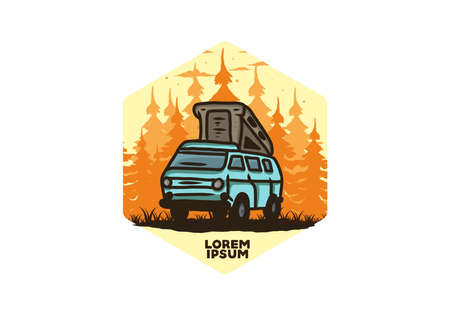Introduction to Rooftop Tents for Car and Truck Camping
If you love hitting the open road, exploring national parks, or camping under the stars across America, youve probably seen rooftop tents popping up everywhere. These tents mount directly on top of your car, SUV, or truck, making camping easier and more comfortable than ever before. Over the past few years, rooftop tents have exploded in popularity among U.S. car campers and overlanders—and it’s easy to see why.
Why Are Rooftop Tents So Popular with American Campers?
Rooftop tents offer a blend of convenience and comfort that traditional ground tents just can’t match. Whether you’re heading out for a weekend getaway or an epic cross-country adventure, these tents help turn your vehicle into a cozy mobile basecamp. Here are some reasons why rooftop tents are now a favorite for car and truck camping in the United States:
| Feature | Benefit for U.S. Campers |
|---|---|
| Quick Setup | Most rooftop tents pop up in minutes—perfect for road trips and spontaneous stops. |
| Elevated Sleeping Platform | Keeps you off the cold, uneven ground and away from critters common in American campgrounds. |
| Built-In Mattresses | Many models include thick foam mattresses for a good night’s sleep after long drives or hikes. |
| All-Weather Protection | Designed to handle rain, wind, and even snow found in diverse U.S. climates. |
| Secure Campsite Anywhere | You’re ready to camp whether you’re at a campground, in the desert, or along a mountain road. |
The American Road Trip Dream—Made Easier
One of the best things about rooftop tents is their compatibility with classic American adventures. Whether youre cruising along Route 66, exploring Yellowstone, or tailgating at a football game, having your tent on your roof means more freedom and flexibility. No need to hunt for flat ground or worry about mud; just park and pop up your tent wherever it’s allowed. That sense of freedom is what makes rooftop tents perfect for embracing the spirit of the American road trip.
2. Key Features to Look for in a Rooftop Tent
Choosing the right rooftop tent is essential for a great camping experience in the U.S. There are several key factors that American campers should consider before making a purchase. Let’s break down what matters most:
Tent Materials and Build Quality
The durability of your rooftop tent depends largely on the materials used. Most high-quality tents are made from ripstop canvas or heavy-duty polyester, which provide excellent protection against wear and tear. For the tent base, look for aluminum or reinforced fiberglass as these materials offer strong support without adding excessive weight.
| Material | Benefits | Drawbacks |
|---|---|---|
| Ripstop Canvas | Highly durable, good insulation, UV resistant | Heavier, may require more care to dry out |
| Polyester | Lightweight, quick-drying, affordable | Less insulation in extreme weather |
| Aluminum Base | Strong, lightweight, rust-resistant | Can be pricier than alternatives |
| Fiberglass Base | Sturdy, insulates well, weatherproof | Slightly heavier than aluminum |
Compatibility with Popular U.S. Vehicles
Not every rooftop tent fits every car or truck. It’s important to ensure the tent is compatible with your specific vehicle. Many brands design tents specifically for popular U.S. models like the Ford F-150, Toyota Tacoma, Jeep Wrangler, and Subaru Outback.
Quick Compatibility Checklist:
- Check your vehicles roof load rating (static and dynamic weight limits).
- Make sure you have appropriate roof racks or crossbars installed.
- Select a tent model that matches the dimensions of your car or truck roof.
- If you drive an SUV or pickup truck, confirm if the tent includes mounting hardware suitable for your rack system.
Weather Resistance for All Seasons
The U.S. has diverse climates—from desert heat to mountain snow—so weather resistance is crucial. Look for these features:
- Waterproofing: Tents should have a rainfly and sealed seams to keep you dry during storms.
- Ventilation: Mesh windows and adjustable vents help manage condensation in humid regions.
- UV Protection: Especially important if you camp in sunny areas like the Southwest.
- Wind Resistance: A low-profile design helps withstand gusts on open plains or coastal sites.
Ease of Setup and Take Down
No one wants to spend hours setting up after a long drive. Hard shell rooftop tents usually set up in under a minute—just pop the latches and lift! Soft shell models often need a bit more time but are still much quicker than traditional ground tents.
| Tent Type | Average Setup Time |
|---|---|
| Hard Shell Rooftop Tent | < 1 minute |
| Soft Shell Rooftop Tent | 5 – 10 minutes |
Comfort Preferences: Space and Mattress Quality
A comfortable night’s sleep can make or break your trip. Consider these aspects:
- Tent Size: Are you camping solo, as a couple, or with family? Check the interior dimensions before buying.
- Mattress Thickness: Most rooftop tents come with built-in foam mattresses (usually 2-3 inches thick). Upgrading to a memory foam topper is an easy way to boost comfort.
- Pockets & Storage: Interior pockets help organize essentials like flashlights and phones.
Tent Size Guide by Group Size:
| # of Campers | Tent Size Needed (L x W) |
|---|---|
| 1 Person | Around 48″ x 84″ |
| 2 People (Couple) | Around 56″ x 96″ |
| Family (3-4) | Around 72″ x 96″ or larger; look for annex rooms for extra space |
Your Rooftop Tent Should Match Your Adventure Style!
If you love exploring remote national parks, prioritize rugged build quality and four-season protection. For weekend getaways at local campgrounds, a lighter tent with easy setup might be perfect. Take time to consider these key features before investing in your rooftop home away from home.
![]()
3. Top Picks: Best Rooftop Tents for Cars and Trucks
If youre ready to take your car or truck camping adventures to the next level, a rooftop tent can make all the difference. Below is a curated list of some of the best rooftop tents available in the U.S., chosen for their build quality, ease of setup, comfort, and versatility. Whether you drive a compact SUV or a full-size pickup, there’s an option here that will fit your needs and vehicle.
Best Rooftop Tents for American Campers
| Brand & Model | Fits Vehicle Type | Key Features | Why It Stands Out |
|---|---|---|---|
| Tepui Explorer Kukenam 3 | SUVs, Trucks, Wagons | All-season, sleeps 3, weatherproof canopy | Durable construction, great for year-round U.S. adventures |
| iKamper Skycamp 2.0 | Cars, SUVs, Trucks (universal) | Hard shell, quick setup, king-size mattress | Spacious and fast to set up—ideal for families on road trips |
| Yakima SkyRise HD Medium | SUVs, Crossovers, Trucks | Rugged material, sleeps 2-3, extra ventilation windows | User-friendly design and trusted American brand support |
| Roofnest Sparrow Eye | Most cars & SUVs | Pop-up hard shell, easy access, built-in mattress | Low-profile and aerodynamic—great for city-to-camp transitions |
| Smittybilt Overlander Tent XL | Larger trucks & SUVs | Sleeps 3-4, heavy-duty construction, annex room option | Perfect for group camping or longer overland journeys in the U.S. |
| Thule Tepui Foothill Tent | Compact cars & crossovers | Narrow footprint, lightweight design, sleeps 2 adults | Leaves space on your roof rack for bikes or gear—ideal for active campers |
What Makes These Tents Stand Out?
- Easy Setup: Many American campers want to spend less time pitching camp and more time enjoying the outdoors. Most of these tents can be set up in minutes.
- Weather-Ready: From the Pacific Northwest rains to the dry Southwest heat, these tents are designed to handle diverse American climates.
- Comfort: Built-in mattresses and spacious interiors mean you’ll sleep better than in a traditional ground tent.
- Diverse Vehicle Compatibility: There’s something here whether you’re driving a compact crossover or a full-sized pickup truck.
Tent Shopping Tips for U.S. Campers:
- Check Your Roof Rack: Make sure your vehicles roof rack is rated to carry both the weight of the tent and its occupants.
- Consider Weather Needs: If you camp all year round, look for four-season options with extra insulation and rain protection.
- Packing Space: Some rooftop tents leave room on your rack for bikes or kayaks—a big plus for adventure-loving Americans.
The right rooftop tent can turn any road trip into a comfortable outdoor escape—just pick one that matches your vehicle and your camping style!
4. Rooftop Tent Installation and Safety Tips
Installing Your Rooftop Tent on American Vehicles
Setting up a rooftop tent on your car, SUV, or pickup truck in the U.S. is easier than you might think, but it’s important to follow the right steps for a secure and safe experience. Here are some key tips tailored for American vehicles:
Choose the Right Roof Rack
Not all roof racks are created equal. Make sure your rack is rated for the weight of your tent plus occupants (check both dynamic and static load ratings). Popular U.S. brands like Thule, Yakima, and Rhino-Rack offer racks compatible with most American vehicles.
| Vehicle Type | Recommended Rack Style | Weight Limit (Average) |
|---|---|---|
| SUV | Crossbars + Platform Rack | 160-220 lbs (dynamic) |
| Pickup Truck | Bed Rack or Cab Over Rack | 250-300 lbs (dynamic) |
| Sedan/Hatchback | Aero Crossbars | 120-165 lbs (dynamic) |
Step-by-Step Installation Tips
- Check Instructions: Always read both your rooftop tent and roof rack manuals before starting.
- Ask for Help: Most tents are heavy—get a buddy to help lift and position it.
- Align Properly: Center the tent over your vehicle for even weight distribution.
- Tighten All Bolts: Use the provided hardware and double-check all fasteners after driving a few miles.
- Ladder Placement: Set the ladder at a 60-70° angle for stability.
Essential Safety Guidelines for U.S. Camping
- Buckle Up Everything: Before hitting the road, make sure your tent is fully closed and latched down.
- No Overloading: Never exceed your rack or tent’s weight limit—even if you’re tempted to bring extra gear.
- Campsite Rules: In national parks and campgrounds, only camp in designated areas. Follow local fire regulations—many places ban open flames near tents.
- Bears & Wildlife: In states like Montana or California, store food in bear-proof containers away from your vehicle. Don’t keep snacks in your tent!
- Weather Watch: Check local weather forecasts before heading out, especially in tornado or flash flood-prone regions.
- Ladder Safety: Always use the ladder provided—no climbing up tires or bumpers.
Packing Checklist: Must-Haves for Safe Rooftop Camping in America
| Item | Why You Need It |
|---|---|
| Tie-down Straps/Bungees | Extra security during windy conditions |
| Tire Chocks/Blocks | Keeps vehicle stable on uneven ground |
| Bearing Grease/Lubricant | Keeps moving parts smooth and quiet |
| First Aid Kit & Flashlight | Makes any emergency easier to handle at night or remote locations |
| Shoe Storage Bag | Keeps muddy shoes outside your sleeping area |
| Pillow & Insulated Sleeping Bag | Adds comfort during chilly U.S. nights outdoors |
If you follow these installation tips and safety guidelines, you’ll be ready to enjoy your rooftop tent adventure—whether that’s a weekend at a local KOA campground, a journey through Yellowstone National Park, or boondocking deep in BLM land.
5. Frequently Asked Questions About Rooftop Tents
Are Rooftop Tents Legal Everywhere in the U.S.?
Rooftop tents are legal to own and use in the U.S., but local regulations can vary—especially when it comes to camping overnight in public spaces or parking lots. Always check with state parks, national forests, and city ordinances before setting up camp on your vehicle. Some places allow overnight parking (like many Walmart stores), while others strictly prohibit it.
How Do I Store My Rooftop Tent When Not in Use?
Proper storage will keep your rooftop tent in good shape for years. Here’s a quick guide:
| Storage Tip | Details |
|---|---|
| Clean & Dry | Always dry out your tent completely before storing to prevent mold and mildew. |
| Location | Store indoors if possible—garages or sheds work great. If outdoors, use a weatherproof cover. |
| Mounting | If you leave it on your vehicle, make sure it’s secure and covered. |
| Disassembly | If removing from your car, have a friend help—it can be heavy and awkward to move alone. |
Can I Use a Rooftop Tent Year-Round?
Most rooftop tents are designed for three-season use (spring, summer, fall). However, some premium models offer four-season protection with thicker insulation and weatherproofing for winter camping. Make sure your tent is rated for the conditions you expect, and consider using an insulated liner or extra blankets during colder months.
What Accessories Should I Consider for Rooftop Camping?
The right accessories can make your trip much more comfortable. Here are some popular add-ons:
| Accessory | Description/Benefit |
|---|---|
| Annex Room | Adds ground-level space for changing or extra gear storage. |
| Ladder Extension | Makes it easier to access the tent on taller trucks or SUVs. |
| Awnings | Provides shade and rain protection next to your vehicle. |
| Shoe Bags/Organizers | Keeps muddy shoes outside the sleeping area. |
| Mattress Upgrades | Adds comfort for better sleep on longer trips. |
| Lighting Kits | LED strips or lanterns brighten up your tent at night. |
Is It Safe to Sleep in a Rooftop Tent?
Yes, rooftop tents are generally very safe when properly installed. They keep you off the ground away from critters and uneven terrain. Just make sure your roof rack is rated for the weight of both the tent and occupants (check dynamic and static weight limits), and always close up ladders securely before turning in for the night.


